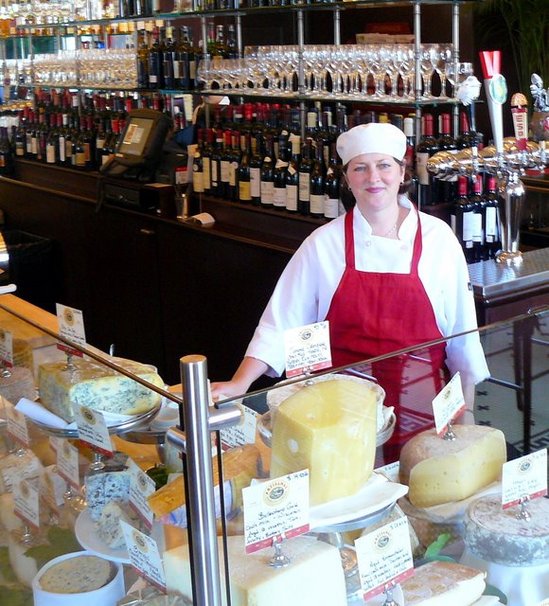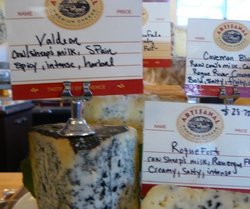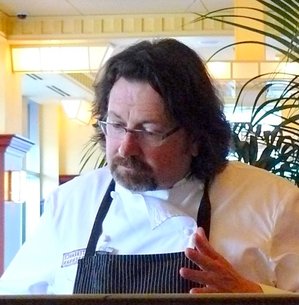
Krista McCorkle Davis, one of three fromagers at Artisanal Brasserie in Bellevue
Banish, immediately, any thoughts of blue-boxed Kraft, of gee-whiz products in spray cans or singularly sliced. Admit that you don't know--don't want to know--jack. "Cheesiest" here refers specifically to the 80-plus selections of artisanally produced wedges, rounds, balls, loaves, cakes, cones, pyramids, logs, bûches, crottins and tommes available at Artisanal, Terrance Brennan's bright and shiny New York-style French brasserie in downtown Bellevue. It is the sheer audacity of this cheese panoply (called "a regional treasure waiting to be discovered" by Seattle Metropolitan), and certainly unmatched locally, that we celebrate.
Arrayed opposite Artisanal's hostess stand, the 20-foot cheese display invites oohing and aahing. Do Whole Foods and Metropolitan Market have as many exotic cheeses? Perhaps. Do independent cheesemongers like Pat McCarthy's DeLaurenti, Dennis Nelson & Theresa Simpson's Cheese Cellar or Sheri LaVigne's new Calf & Kid on Capitol Hill? More, even. But they're not running a full-service, sit-down, white-tablecloth restaurant like this centerpiece of the new Bravern development.
Cheese making evolved as a means of transforming milk proteins (the essential nourishment of all mammalian species) into something more permanent and portable. It's not terribly convenient, after all, to travel with a herd of goats. What we call the "ripening" of cheese is in fact its destruction by mold.
The question, once you get past the basics, is why France (for instance) has so many distinctly different cheeses. The answer is in the diversity of molds. Much is written about terroir, the sense of place conveyed by cheese and wine, but terroir is not just what the cows or goats or ewes eat, it's also the naturally occurring bacteria in the cheese caves (or, for wine, the naturally occurring yeasts in the vineyards). For example, geotrichum candidum, which produces the unique ripening and flavor characteristics of one cheese from the volcanic Auvergne region in central France, St. Nectaire. Cheese, like wine, is alive, at least when it's unpasteurized. (Pasteurizing milk--heating it for 15 seconds at 161 degrees--kills the natural bacteria but strips the cheese of the very microbes that give it its unique character.)
And it's a chicken & egg conundrum for dairy farmers. They'd make more raw milk cheese if there were more outlets (and less fussy regulation); there'd be more points of sale if there were more demand. It's hard to be a stand-alone cheese monger competing against supermarkets; it's no easier for the cheese producers to drive hundreds of miles to a big-city farmers market and sell directly to consumers. But the system is slowly cranking up, with the commitment of restaurants playing an important role.
 Some 15 years ago, you had to go to Europe for a cheese course; today, every New York restaurant serves cheese. At Artisanal in Bellevue, you can order any cheese à la carte, but the default is to opt for one of the themed cheese & wine flights. They're grouped by origin (French, Italian, Iberian, Northwest) by type (goat, mountain, cheddar, blue), by wine (sweet, sparkling, even beer). Three cheeses, $12.50. Add three wines, it's $28.50. You can saunter up to the display and point to the cheeses you want, you can peruse the menu and check off the boxes; you can ask for the fromager's advice. (One of the three fromagers on staff in Bellevue, Krista McCorkle Davis, spent four years helping her husband, Mike, run the highly respected 26 Brix restaurant in Walla Walla.) You can also add fruit or charcuterie (Prosciutto di Parma, Jamon Iberico, coppa, sopressata).
Some 15 years ago, you had to go to Europe for a cheese course; today, every New York restaurant serves cheese. At Artisanal in Bellevue, you can order any cheese à la carte, but the default is to opt for one of the themed cheese & wine flights. They're grouped by origin (French, Italian, Iberian, Northwest) by type (goat, mountain, cheddar, blue), by wine (sweet, sparkling, even beer). Three cheeses, $12.50. Add three wines, it's $28.50. You can saunter up to the display and point to the cheeses you want, you can peruse the menu and check off the boxes; you can ask for the fromager's advice. (One of the three fromagers on staff in Bellevue, Krista McCorkle Davis, spent four years helping her husband, Mike, run the highly respected 26 Brix restaurant in Walla Walla.) You can also add fruit or charcuterie (Prosciutto di Parma, Jamon Iberico, coppa, sopressata).
The fromagers preference is for the most local first, since it can be replenished quickly when it runs out. One favorite: Hillis Peak, a tangy, raw-milk goat cheese produced from the prizewinning herd of Nigerian dwarf goats at Pholia Farm outside Rogue River, Ore. It makes the centerpiece of a cheese-centric meal, it's a starter, it's a dessert course,
What happens to the leftover cheese? Some of it undoubtedly ends up in the fondue du jour or the Artisanal blend ($20 for two). But Brennan says there's less waste than you'd think; his staff buys judiciously and know how to sell the cheeses they bring in. Baskets, platters, catered events.
 Brennan opened his first restaurant, Picholine, in 1993, introducing the traditional European cheese course to American diners. (In 2007, it was named America's outstanding restaurant by the James Beard Foundation.) In 2001 he opened Artisanal Bistro on Park Avenue in midtown Manhattan with a traditional brasserie menu and 150 wines by the glass. Two years later he founded Artisanal Premium Cheese, a separate affinage and distribution company with a 10,000-square-foot facility housing five cheese-ripening "caves," each with its own temperature, humidity and controlled airflow.
Brennan opened his first restaurant, Picholine, in 1993, introducing the traditional European cheese course to American diners. (In 2007, it was named America's outstanding restaurant by the James Beard Foundation.) In 2001 he opened Artisanal Bistro on Park Avenue in midtown Manhattan with a traditional brasserie menu and 150 wines by the glass. Two years later he founded Artisanal Premium Cheese, a separate affinage and distribution company with a 10,000-square-foot facility housing five cheese-ripening "caves," each with its own temperature, humidity and controlled airflow.
Brennan had set his sights on Chicago for his initial venture outside of New York, but the financing collapsed. Schnitzer West recruited him for the Bravern with what must have been highly favorable terms for a buildout and lease. In the end, he put in two adjacent spots, Artisanal Brasserie & Wine Bar, with 185 seats, room for 50 more at the bar, and direct access to the Bravern's tony second level plaza (Hermès, Louis Vuitton, Ferragamo) and a less formal, 70-seat pizzeria, The Artisanal Table, just past the concierge desk inside the residential lobby. Over 300 seats in all, an 90-employee operation that requires oversight visits, every month or so, from Brennan himself as well as his top New York managers. (The GM at Picholine, Jason Miller, is in charge of the wine program at all Brennan's restaurants; when he comes to Bellevue, he introduces himself modestly as the sommelier.)
For many Europeans, a brasserie needs to have some patina before it's taken seriously, and Artisanal--though it has all the right elements of decor, from the tiled floor to the brass rails, green leather banquettes, cane chairs, palm fronds (palm fronds?)--looks just a shade too bright and shiny. In the restaurant's earliest days, some of the staff wasn't up to speed; Seattle Weekly's Jonathan Kauffman famously skewered a server in the pizzeria who had only a rudimentary knowledge of the company's flagship products. (Granted, it was the pizzeria, not the main room, but Brennan was sorely miffed.) Yet it's the very lack of dents and scratches, not to mention its fashionista neighbors, that will likely make Artisanal attractive to eastside diners, who seem to prefer original to repurposed space (almost any place in Belltown, Fremont, Ballard or Capitol Hill)
Executive Chef Seisuke Kamimura appears comfortable with Artisanal's traditional brasserie offerings (foie gras, pot au feu, halibut with a lemon-parmesan foam, steak au poivre, rhubarb tart), all served wth the no-nonsense (but gracious) formality familiar to anyone who's been to La Coupole or Balzar in Paris. It's not haute cuisine, of course, but quite delightful, even if you wish the room were busier, noisier.
"We're still fine-tuning," Brennan admits. A soup & salad combo, grilled cheese sandwiches, more accessible menus. Even, heaven forfend, a happy hour. "We never had to do that in New York."
Meantime, should you be so disposed, the American Cheese Society is holding its annual conference in Seattle this summer. Agenda and guest registration details here.
Artisanal Brasserie & Wine Bar, in the Bravern, 11111 NE 8th, Bellevue, 425 372 2200 
Leave a comment